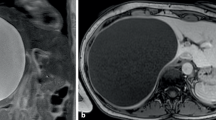Abstract
Background
Liver tumors located in segments 7 and 8 pose a technical challenge to standard laparoscopic liver resection. Intraoperative placement of a surgical glove behind the right liver after the right triangular ligament and coronary ligament are divided facilitates liver exposure during parenchymal transection and control of the bleeding at the deeper part of the parenchymal plane. The aim of this study was to describe our standardized technique in detail and to assess the feasibility of this technique in patients with different clinical backgrounds and clarify the limits of this technique.
Methods
Medical records of 20 consecutive patients considered for laparoscopic liver resection using the surgical glove technique were reviewed.
Results
All patients had malignant disease and the vast majority of patients had colorectal metastatic tumors. Overall, 65% of patients had tumors located in segment 8. Placing the surgical water glove could be achieved without complication in all 20 patients. One surgical glove was used in this series (usually size 6.5 to 7.5 is an adequate size). Time for preparing the surgical green water glove was estimated to be less than 1 min. The mean duration of operation ranged from 136 to 332 min (median, 240 min). Intermittent Pringle’s maneuver was applied in all patients with a median time of 33 min. No additional intercostal trocars were required. There was no intraoperative blood transfusion or conversion to open surgery. The median maximum size of the tumor was 23 mm. There was no operative mortality. Overall morbidity was 30%. Surgical margins were negative in 80% of patients.
Conclusions
The surgical glove technique is easy, reproducible, effective, and safe and can be applied to both laparoscopic and robotic liver resection.





Similar content being viewed by others
References
Belli G, Fantini C, D'Agostino A, Cioffi L, Limongelli P, Russo G, Belli A. Laparoscopic segment VI liver resection using a left lateral decubitus position: a personal modified technique. J Gastrointest Surg. 2008; 12: 2221–6.
Ikeda T, Toshima T, Harimoto N, Yamashita Y, Ikegami T, Yoshizumi T, Soejima Y, Shirabe K, Maehara Y. Laparoscopic liver resection in the semiprone position for tumors in the anterosuperior and posterior segments, using a novel dual-handling technique and bipolar irrigation system. Surg Endosc. 2014; 28: 2484–92.
Okuda Y, Honda G, Kurata M, Kobayashi S, Sakamoto K, Takahashi K. A safe and valid procedure for pure laparoscopic partial hepatectomy of the most posterosuperior area: the top of segment 7. J Am Coll Surg. 2014; 220: e17–21.
Ichida H, Ishizawa T, Tanaka M, Terasawa M, Watanabe G, Takeda Y, Matsuki R, Matsumura M, Hata T, Mise Y, Inoue Y, Takahashi Y, Saiura A. Use of intercostal trocars for laparoscopic resection of subphrenic hepatic tumors. Surg Endosc. 2016; 31: 1280–6.
Hirokawa F, Hayashi M, Asakuma M, Shimizu T, Inoue Y, Uchiyama K. Intercostal Trocars Enable Easier Laparoscopic Resection of Liver Tumors in Segments 7 and 8. World J Surg. 2017; 41: 1340–6.
Lee W, Han HS, Yoon YS, Cho JY, Choi Y, Shin HK. Role of intercostal trocars on laparoscopic liver resection for tumors in segments 7 and 8. J Hepatobiliary Pancreat Sci. 2014; 21: E65–8.
Chiow AK, Lewin J, Manoharan B, Cavallucci D, Bryant R, O'Rourke N. Intercostal and transthoracic trocars enable easier laparoscopic resection of dome liver lesions. HPB (Oxford). 2014; 17: 299–303.
Teramoto K, Kawamura T, Takamatsu S, Noguchi N, Nakamura N, Arii S. Laparoscopic and thoracoscopic partial hepatectomy for hepatocellular carcinoma. World J Surg. 2003; 27: 1131–6.
Cloyd JM, Visser BC. Video-assisted thoracoscopic transdiaphragmatic liver resection for hepatocellular carcinoma. Surg Endosc. 2011; 26: 1772–6.
Bin J, Binghai Z, Sanyuan H. Liver Exposure Using Sterile Glove Pouch During Laparoscopic Right Liver Surgery in Hepatocellular Carcinoma Patients. World J Surg. 2015; 40: 946–50.
Kawai T, Goumard C, Jeune F, Komatsu S, Soubrane O, Scatton O. 3D vision and maintenance of stable pneumoperitoneum: a new step in the development of laparoscopic right hepatectomy. Surg Endosc. 2018; 32: 3706–12.
Kawai T, Goumard C, Jeune F, Savier E, Vaillant JC, Scatton O. Laparoscopic liver resection for colorectal liver metastasis patients allows patients to start adjuvant chemotherapy without delay: a propensity score analysis. Surg Endosc. 2018; 32: 3273–81.
Soubrane O, Schwarz L, Cauchy F, Perotto LO, Brustia R, Bernard D, Scatton O. A Conceptual Technique for Laparoscopic Right Hepatectomy Based on Facts and Oncologic Principles: The Caudal Approach. Ann Surg. 2014; 261: 1226–31.
Komatsu S, Brustia R, Goumard C, Sepulveda A, Perdigao F, Soubrane O, Scatton O. Clinical impact of laparoscopic hepatectomy: technical and oncological viewpoints. Surg Endosc. 2016; 31: 1442–50.
Komatsu S, Scatton O, Goumard C, Sepulveda A, Brustia R, Perdigao F, Soubrane O. Development Process and Technical Aspects of Laparoscopic Hepatectomy: Learning Curve Based on 15 Years of Experience. J Am Coll Surg. 2017; 224: 841–50.
Author information
Authors and Affiliations
Contributions
Study conception and design: Tabath, Lim, Goumard, and Scatton
Acquisition of data: Tabath, Lim, Goumard, and Scatton
Analysis and interpretation of data: Tabath, Lim, Goumard, and Scatton
Drafting of manuscript: Tabath, Lim, Goumard, and Scatton
Critical revision: Tabath, Lim, Goumard, and Scatton
Final approval of the article: Tabath, Lim, Goumard, and Scatton
Corresponding author
Ethics declarations
Conflict of Interest
The author declare that they have no conflict of interest.
Additional information
Publisher’s Note
Springer Nature remains neutral with regard to jurisdictional claims in published maps and institutional affiliations.
Martin Tabath and Chetana Lim are co-first authors
Electronic supplementary material
ESM 1
(WMV 254493 kb).
Rights and permissions
About this article
Cite this article
Tabath, M., Lim, C., Goumard, C. et al. Surgical Glove Technique for Laparoscopic Liver Resection. J Gastrointest Surg 24, 1912–1919 (2020). https://doi.org/10.1007/s11605-020-04577-8
Received:
Accepted:
Published:
Issue Date:
DOI: https://doi.org/10.1007/s11605-020-04577-8




